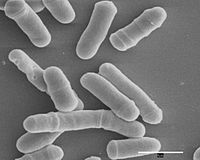
Photo from wikipedia
Abstract Rif1 mediates telomere length, DNA replication, and DNA damage responses in budding yeast. Previous work identified several posttranslational modifications of Rif1, however none of these was shown to mediate… Click to show full abstract
Abstract Rif1 mediates telomere length, DNA replication, and DNA damage responses in budding yeast. Previous work identified several posttranslational modifications of Rif1, however none of these was shown to mediate the molecular or cellular responses to DNA damage, including telomere damage. We searched for such modifications using immunoblotting methods and the cdc13-1 and tlc1Δ models of telomere damage. We found that Rif1 is phosphorylated during telomere damage, and that serines 57 and 110 within a novel phospho-gate domain (PGD) of Rif1 are important for this modification, in cdc13-1 cells. The phosphorylation of Rif1 appeared to inhibit its accumulation on damaged chromosomes and the proliferation of cells with telomere damage. Moreover, we found that checkpoint kinases were upstream of this Rif1 phosphorylation and that the Cdk1 activity was essential for maintaining it. Apart from telomere damage, S57 and S110 were essential for Rif1 phosphorylation during the treatment of cells with genotoxic agents or during mitotic stress. We propose a speculative “Pliers” model to explain the role of the PGD phosphorylation during telomere and other types of damage.
Journal Title: Molecular and Cellular Biology
Year Published: 2023
Link to full text (if available)
Share on Social Media: Sign Up to like & get
recommendations!